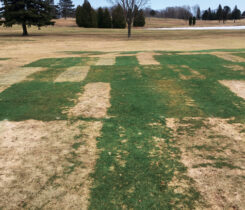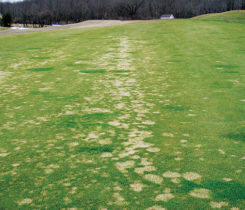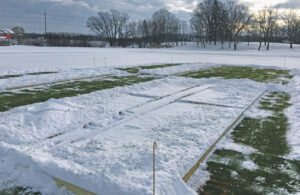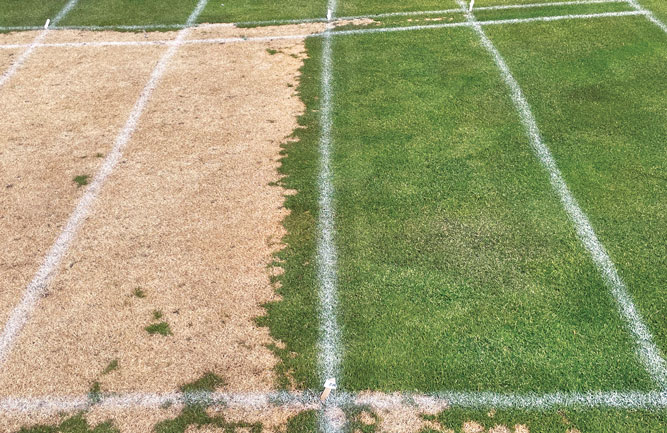Snow mold strikes again

Figure 1 Snow mold pressure at our research station in Madison, Wis. was very high despite a relatively short window of snow cover. (Photo: Paul Koch)
By my count, this is the eighth consecutive year I’ve written a snow mold article for Golfdom. Over these eight years, some things have been constants, such as the need to mix multiple active ingredients for acceptable disease control in heavy-pressure environments. Other things are specific to each year, such as how minor environmental changes over a small area can lead to large changes in disease development.
This article will be much the same. Certain things you’ve heard me say before (you need multiple actives if you’re in a high-pressure area) and others you haven’t because I haven’t mentioned them. Let’s take a look back at the 2019-2020 winter to help us prepare for 2020-2021.
Turf hardening impacts snow mold resistance … a lot
From an environmental standpoint, last fall and winter in the Midwest were drunk. An early and prolonged cold snap in October and November caused early course closures and a mad rush to blow out irrigation systems and get out snow mold applications.
In Madison, we got almost 6 inches of snow on Halloween, which made for some difficult trick-or-treating. Fast-forward to December, and the weather felt more like September. Multiple weeks with high temperatures in the 40s and 50s culminated in a 54 degree F Christmas Day and a Koch household Christmas party that moved to the back patio. Winter returned on Jan. 1 when snow fell, and it stuck until mid-March.
Discussion among superintendents in Wisconsin centered around how much snow mold would develop and whether breakthrough would occur in treated areas. I was unsure, torn between conflicting indicators. On the one hand, there was snow on the unfrozen ground, which generally leads to lots of snow mold. On the other hand, the snow fell late, was never that deep and barely lasted 60 days.

Figure 2 Average monthly snowfall in Madison, Wis., has increased over the last 10 years in January and February but has fallen significantly in November and December. December is usually a critical time for snow mold development. The figure is taken from this website. (Photo: Paul Koch)
In the end, snow mold pressure was very high across most of Wisconsin and the upper Midwest (Figure 1). This indicated that even with a short window of snow cover, the lack of turf hardening allowed for widespread snow mold to develop on nontreated turf. Turf hardening is a complex process that allows the turf to be ready for the winter ahead and is a critical component for snow mold resistance.
Fortunately, snow mold breakthrough on treated turf was very rare, suggesting that snow mold applications made in October and November knocked back the fungal population enough so that it couldn’t recover and cause disease before the snow melted in spring.
Our changing winters make it difficult to consistently predict how climate change will impact future snow mold development. Prior to this year, most of the evidence I observed suggested that climate change was resulting in later and less snow cover and less disease development (Figure 2). But, 2019-2020 showed that warmer temperatures in late fall could lead to “dehardening” of the turf, which results in widespread snow mold development on turf that is, for lack of a better phrase, “unprepared for winter.” How this plays out with further climate change in the years ahead will be interesting (and essential) to watch.
Fungicide timing matters
Timing of snow mold fungicide applications is something I have talked about before, but the 2019-2020 winter provided a great example of just how important it is. Applying snow mold fungicides too late (i.e., when snow is already on the ground) is bad. However, applying them too early is also bad, most likely due to a combination of product breakdown before snow cover and the snow mold fungi not actively growing (and not taking up) the fungicide at the time of application.

Figure 3 There can be a sharp cutoff in effective snow mold control. At our research site on Timber Ridge GC in Minocqua, Wis., the difference between no control and great control was just 12 days. (Photo: Paul Koch)
But what is too early, and how do you determine the optimal time to apply when the conditions fluctuate so much from year to year?
To investigate this, we have researched optimal snow mold fungicide timing for the past five years. The study is straightforward; we apply Instrata (combines the active ingredients chlorothalonil, propiconazole and fludioxonil) once at various times prior to “expected” snow cover for that particular site and then rate how much snow mold developed on the site the following spring. The application timings are eight, six, four, two, and zero weeks before the expected snow cover.
At our research site in Minocqua, Wis., in 2019-2020, the cutoff from almost no control (applied Oct. 14) to excellent control (applied Oct. 26) was only 12 days (Figure 3). The control increased dramatically over the same two application dates at research sites in Wausau in central Wisconsin and Madison in southern Wisconsin.
As part of this project, we have also researched various environmental measurements that can effectively predict the optimal timing. To date, the most effective has been “heating degree days.” Heating degree days are the opposite of growing degree days because you set a base temperature (we use 50 degrees F), and beginning on July 1 of each year, record how much below 50 degrees F the average daily temperature was.

Figure 4 I thought that repeatedly applying iron sulfate (Extreme Green) and potassium phosphite (Duraphite) throughout the fall would knock back the snow mold fungal population and provide significant disease control. As this photo from Timber Ridge GC in Minocqua, Wis., shows … I was wrong. (Photo: Paul Koch)
From our past research, we know that increases in snow mold control are seen when fungicide applications are made at heating degree day accumulations right around 100, and that is precisely what we saw at these three sites in 2019-2020. More research is needed across more locations. Still, we know that fungicide timing is essential for snow mold control, and we’re making progress on ways to predict when that optimal timing will be.
Effective alternative snow mold products don’t yet exist
There are a host of alternatives to traditional fungicides that have provided some level of efficacy against certain turf diseases. For example, iron sulfate can reduce dollar spot and phosphites are effective against Pythium blight. Even Microdochium patch that occurs in snowless areas of the Pacific Northwest and northern Europe can be controlled using combinations of iron sulfate, Civitas mineral oil and phosphites. However, we haven’t yet found an alternative product that is effective against traditional snow molds.
We have tested Civitas many times with poor results. This past winter, we tested a potential new biocontrol agent with poor results. We even tested applications of iron sulfate and phosphite applied six times on a two-week interval throughout the fall leading up to snow cover and still had poor results (Figure 4).
The bottom line is that there remains considerable interest in developing alternative methods to control snow mold in areas where snow cover persists, but right now, those options don’t exist.
Mix those active ingredients
Every year, I talk about mixing multiple active ingredients for successful snow mold control, and our research this year once again showed how important that is. We conducted snow mold research at four sites in 2019-2020: Marquette GC in Marquette, Mich.; Timber Ridge GC in Minocqua, Wis.; Wausau CC in Wausau, Wis.; and the OJ Noer Turfgrass Research Facility in Madison, Wis.

Figure 5 Many treatments provide highly effective snow mold control despite really high disease pressure at our research site on Marquette GC in Marquette, Mich. (Photo: Paul Koch)
Snow mold pressure was high at all four sites, and in all of them, the only products that performed well were those that had mixtures of three or more active ingredients. In Marquette, the main snow mold present was speckled snow mold (Typhula ishikariensis), and the amount of disease in the nontreated control was a whopping 87.5 percent. In Wausau, the main snow mold present was Microdochium patch (Microdochium nivale), and the amount of disease in the nontreated control was high at 71 percent.
Even under these heavy disease pressures, there were plenty of treatments that provided highly effective control (Figure 5). At Marquette, there were 16 of 63 treatments that allowed less than 5 percent disease, and at Wausau, 28 of the 63 treatments allowed less than 1 percent disease to occur.
The common theme among all of these successful treatments is that they contained three or more active ingredients. While the specific mixtures varied, almost all of them included a DMI fungicide, such as tebuconazole or propiconazole, a contact fungicide such as chlorothalonil or PCNB, and an additional active ingredient such as pyraclostrobin, azoxystrobin or iprodione.
I strongly encourage you to view the full research results at the University of Wisconsin’s Turfgrass Diagnostic Lab Fungicide Results page and contact me with any questions you have.
Research takeaways
- Snow mold breakthrough on fungicide-treated turf was very rare, suggesting that snow mold applications made in October and November knocked back the fungal population.
- We see increases in snow mold control when fungicide applications are made at heating degree day accumulations right around 100 (i.e., from July 1 of each year, record how much below 50 degrees F the average daily temperature was during the day).
- We have not found alternative methods (e.g., Civitas or phosphites) to control snow mold in areas where snow cover persists.
- The combination of three or more active ingredients applied at Marquette, Wis., resulted in 16 of 63 treatments with less than 5 percent disease, and at Wausau, Wis., 28 of the 63 treatments allowed less than 1 percent disease to occur.
- Almost all effective mixtures included a DMI fungicide (tebuconazole or propiconazole), a contact fungicide (chlorothalonil or PCNB) and an additional active ingredient such as pyraclostrobin, azoxystrobin or iprodione.
Paul Koch, Ph.D., is an assistant professor within the Department of Plant Pathology at the University of Wisconsin, Madison, Wis. Koch can be contacted at plkoch@wisc.edu.
Acknowledgments
I want to acknowledge and thank my field research manager, Kurt Hockemeyer, for organizing and implementing our research trials. Also, a huge thank you to the host superintendents that allow us to conduct this research and provide this great information to all of you: Craig Moore at Marquette GC, Jay Pritzl at Timber Ridge GC and Randy Slavik and Aaron Hansen at Wausau CC. Lastly, thank you to Adjuvants Plus, AMVAC, BASF, Bayer, Belchim, FMC, Nufarm, PBI-Gordon, Precision, PrimeSource, SePro, Simplot, Quali-Pro and Syngenta for supporting this research.












